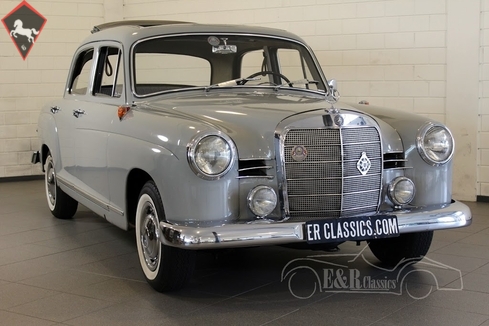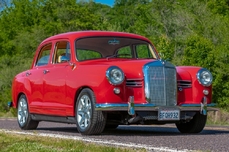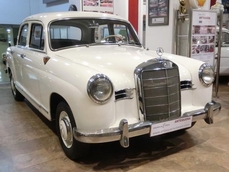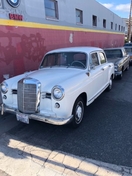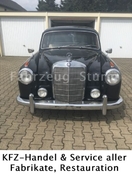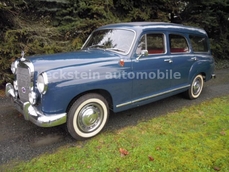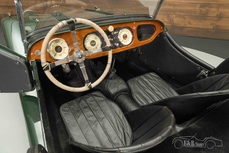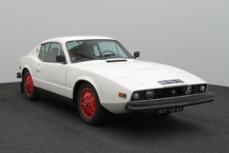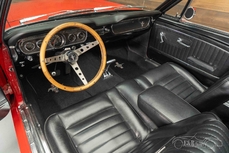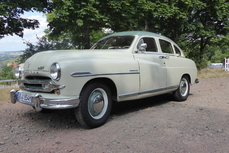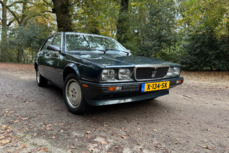Mercedes-Benz 190 Ponton 1962
General description :
Mercedes Benz 180 C Ponton 1962 in very good condition with sunroof
The 180 C Ponton (W120) is a 4 door Mercedes Benz saloon, built between 1953 and 1962. Only 9280 of the 180 C were built between 1961 and 1962. This 1962 Mercedes has a beautiful body and interior.The car is in Holland since 1974 and the last owner owned this car since 1996. The car has a 1897 CC engine and manual gearbox. So a very beautiful Mercedes Benz 180 C. Technics in very good condition.
Car has Holland title and Holland mot/tuv. Easy to register in every EU country. You do not need to pay any importtaxes. We can help with transport.
Mercedes Benz 180 C Ponton 1962 en tres bon etat avec toit ouvrant
La 180 C Ponton (W120) est une Mercedes Benz berline (4 portes) fabriquee entre 1953 et 1962. Seulement 9280 de 180 C sont fabriquees entre 1961 et 1962. Cette Mercedes de 1962 a interieur et exterieur en tres belle etat. Voiture est en Hollande depuis 1974. Le derniere proprietair avait eu cette voiture depuis 1996. Elle a moteur de 1897 CC et boite manuelle. Une tres belle Mercedes Benz 180 C. Technique en tres bon etat.
Carte Grise Pays Bas et controle technique Pays Bas. Simple d’immatriculer en France ou Belgique. Livraison possible. Echange, achat et mediation possible. Pour nos clients francaises livraison CG et CT francais possible. Pour nos clients Belge livraison en Oldtimerplaque possible.
Lorsque vous nous achetez un véhicule vous n'êtes redevable d'aucune taxe d'importation.
S'ajoutent au prix de vente uniquement le coût du contrôle technique et les frais de carte grise.
Mercedes Benz 180 C Ponton 1962 in sehr gutem Zustand mit Schiebedach
Der 180 C Ponton (W120) ist ein Mercedes Benz berline (4 Türe), gebaut worden zwischen 1953 und 1962. Nur 9280 der 180 C sind gebaut worden zwischen 1961 und 1962. Dieser Mercedes ist aus 1962 und Karosserie so wie Innenausstattung sind in sehr schönem Zustand. Das Auto ist in Holland seit 1974 und der letzte Besitzer hatte das Auto seit 1996. Auto hat einen 1897 CC Motor mit Handgetriebe. Also einen sehr schönen und technisch sehr guten Mercedes Benz 180C.
Auto hat hollandisches Kennzeichen und hollandische TUV. Einfach zu registrieren in jedes EU land. Sie bezahlen kein Importsteuer. Wir konnen helfen mit Transport. Eintausch moglich. Wir konnen das Auto gegen mehrpreis mit deutsche TUV, H-Kennzeichen und Fahrzeugbrief liefern.
Mercedes-Benz 180 C Ponton 1962 in zeer goede staat met zonnedak
De 180 C Ponton (W120) is een vierdeurs sedan van Mercedes-Benz die gemaakt werd tussen 1953 en 1962. Ruim 118.000 exemplaren werden er gemaakt van de W120 maar slechts 9280 van de 180 C tussen 1961 en 1962. Dit in het laatste jaar 1962 gebouwde exemplaar verkeert zowel van binnen als van buiten in een zeer mooie conditie. De auto is al sinds 1974 in Nederland en de vorige eigenaar had de auto al sinds 1996. Hij heeft Nederlands kenteken en beschikt over Nederlandse APK keuring. De motor betreft een 1897CC motor en is gekoppeld aan de handgeschakelde versnellingsbak. Kortom een zeer mooie en technische zeer goede Mercedes-Benz 180 C.
http://www.erclassics.com/Mercedes%20Benz-180-classic-car-for-sale-1467.php
1962 Mercedes-Benz 190 Ponton is listed sold on ClassicDigest in Waalwijk by E R Classics for €22950.
Car Facts
Car type : Car Make : Mercedes-Benz Model : 190 Ponton Engine size : 0.0 Model Year : 1962 Location : Waalwijk
Sold
Seller Information
Sold
People who viewed this Mercedes-Benz 190 Ponton also viewed similar Mercedes-Benz listed at ClassicDigest
Other cars listed for sale by this dealer
About Mercedes-Benz
In the annals of automotive history, the journey of Mercedes-Benz is a tale that unfolds with the ingenuity of its founding pioneers. In the year 1886, Karl Benz crafted the Benz Patent Motorwagen, a creation that would go down in history as the world's inaugural automobile. Unbeknownst to him, this moment marked the genesis of what would evolve into the most illustrious premium car manufacturer globally. The financial underpinning of this pioneering venture, interestingly, was provided by Karl Benz's wife, Bertha Benz, demonstrating a remarkable partnership that would set the tone for Mercedes-Benz's legacy.A parallel narrative emerged not far away, as Daimler-Motoren-Gesellschaft, founded by Gottlieb Daimler and Wilhelm Maybach, entered the scene. In 1901, they unveiled their automobile under the now-famous moniker "Mercedes," meaning "godsend" in Spanish. This name was bestowed upon the car at the behest of Emil Jellinek's daughter, the distributor for Daimler-Motoren-Gesellschaft. The wheels of innovation were set in motion.
Fast forward to 1926, a pivotal year that witnessed the merger of Daimler with Benz & Cie., culminating in the birth of Daimler-Benz. The amalgamation saw the adoption of "Mercedes-Benz" as the distinguished trademark for their automobiles, fusing the legacies of two visionary entities into one.
Contrary to perceptions of conservatism, the trajectory of Daimler-Benz unfolds as a chronicle of industry firsts. From the introduction of the honeycomb radiator to the float carburetor, and the pioneering implementation of four-wheel brakes in 1924, Daimler-Benz consistently pushed the boundaries of automotive innovation. The diesel-powered Mercedes-Benz 260 D in 1936 marked the inception of diesel engines in passenger cars. The iconic Mercedes-Benz 300SL Gullwing made history as the first car with direct fuel injection, albeit the Gutbrod's tiny 2-stroke engine can claim precedence.
Safety innovations became a hallmark, with Béla Barényi's patented safety cell design in the "Ponton"-models in 1951, featuring front and rear crumple zones. The W116 450SEL 6.9 saw the introduction of the Anti-Lock Brake system (ABS), another pioneering safety feature. From the first production airbags and beyond, the legacy of "firsts" continued to be etched into the fabric of Daimler-Benz.
Over its centennial journey, Mercedes-Benz has not merely produced cars but has sculpted automotive icons. The SSKL, 710 SSK Trossi Roadster, 770K Grosser, 540K Spezial Roadster, 300SL Gullwing, w100 600 Pullman, w111 280SE 3.5 Flachkühler, w113 230SL Pagoda, w109 300 SEL 6.3, and w201 2.3-16 Cosworth stand testament to the brand's commitment to engineering excellence.
The roaring Silver Arrows, or "Silberpfeile," including the W 25, W 125, W154, W165, and W196, created a legacy of dominance on the racetrack. These machines were not merely cars; they were expressions of precision, speed, and an indomitable spirit that left their competitors in the dust.
As Mercedes-Benz marches into the future, it does so not just as an automaker but as a custodian of a legacy, a torchbearer of innovation, and a beacon of automotive excellence. The road ahead is sure to witness the continued fusion of cutting-edge technology, timeless design, and an unwavering commitment to setting new standards in the world of automobiles.
One luminary figure who left an indelible mark was Béla Barényi, often heralded as the "father of passive safety" for his pioneering work in safety engineering. His patented safety cell design, featuring front and rear crumple zones, became a hallmark of Mercedes-Benz's commitment to occupant safety, setting new standards that reverberated throughout the automotive world.
Moving through the chronicles, the collaborative genius of Wilhelm Maybach, alongside Gottlieb Daimler, laid the foundation for Daimler-Motoren-Gesellschaft. Their innovations not only birthed the first Mercedes but established a culture of relentless pursuit of technological excellence that remains integral to Mercedes-Benz's DNA.
In the post-merger era of 1926, Ferdinand Porsche emerged as a prominent figure within Mercedes-Benz. His work on the Mercedes-Benz S-Type, a supercharged race car, garnered acclaim and set the stage for a legacy that extended far beyond the marque. Porsche's impact would later extend to his eponymous company, but his influence at Mercedes-Benz during those formative years was pivotal.
As the 20th century progressed, the legendary Rudolf Uhlenhaut emerged as a key figure. Uhlenhaut, an accomplished engineer and the driving force behind the iconic Silver Arrows, played a crucial role in Mercedes-Benz's dominance in motorsports. His engineering prowess and attention to detail were instrumental in creating some of the most formidable racing cars of the era.
In the latter half of the century, figures like Bruno Sacco, the head of design at Mercedes-Benz from 1975 to 1999, left an indelible imprint on the brand's aesthetic identity. Sacco's design philosophy, characterized by clean lines and timeless elegance, shaped iconic models like the W126 S-Class and the W201 190E, solidifying Mercedes-Benz's reputation for luxury and sophistication.
The narrative would be incomplete without acknowledging the contributions of engineers like Hans Scherenberg, whose leadership in the 1970s ushered in a new era of technological innovation at Mercedes-Benz. Scherenberg's tenure saw the development of groundbreaking technologies, including the Anti-Lock Brake system (ABS) and the introduction of airbags in production cars.
